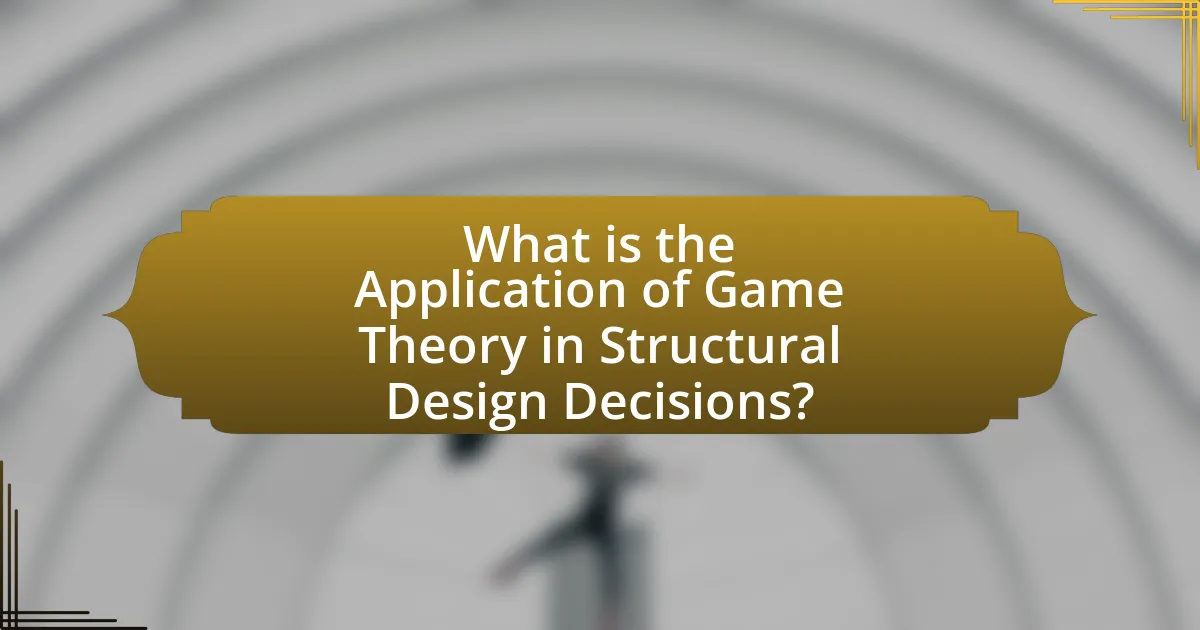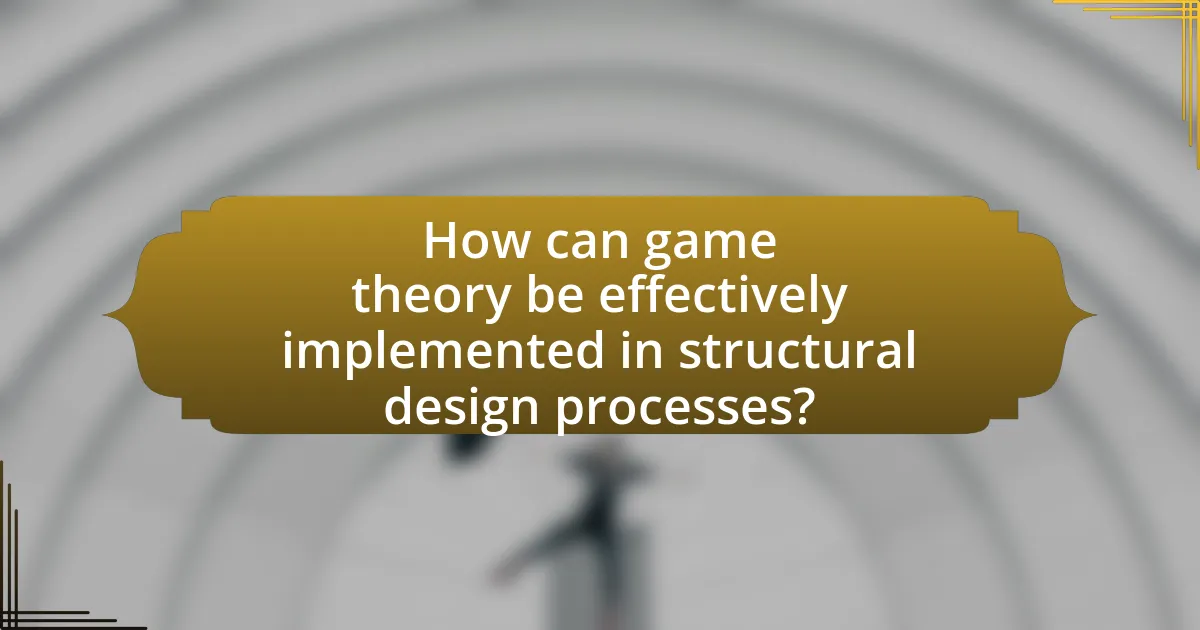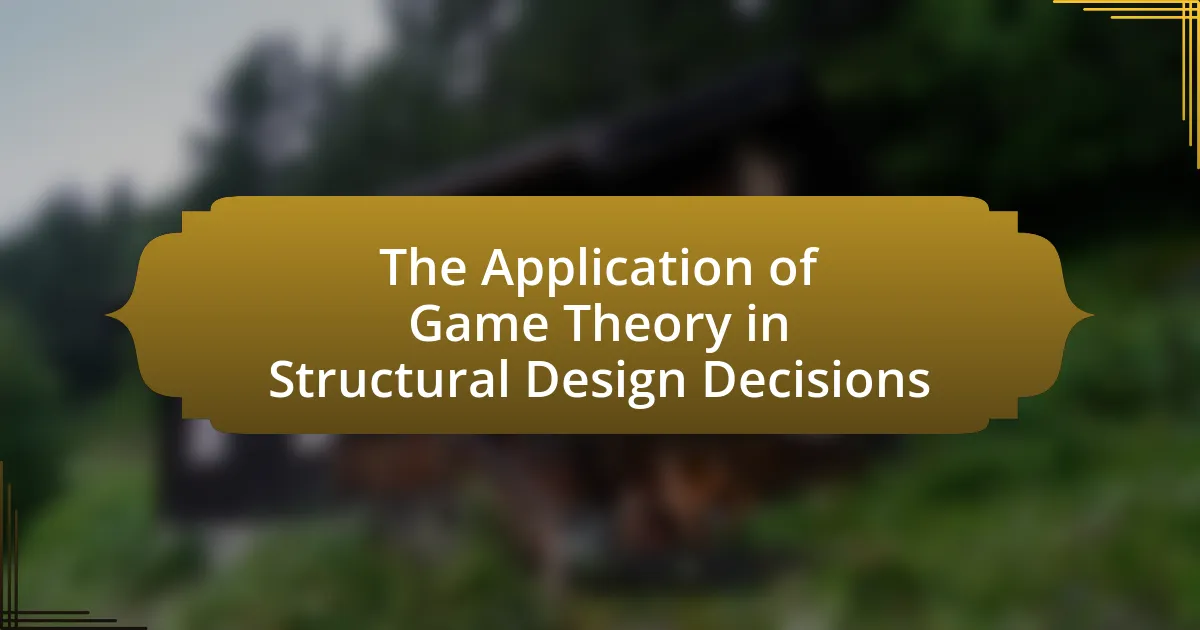The article focuses on the application of game theory in structural design decisions, emphasizing its role in optimizing resource allocation and enhancing collaboration among stakeholders such as architects, engineers, and contractors. It outlines how game theory provides a framework for analyzing strategic interactions, predicting outcomes, and managing conflicting interests, ultimately leading to improved project efficiency and cost savings. Key principles such as Nash equilibrium and Pareto efficiency are discussed, along with the challenges of modeling complex stakeholder dynamics. The article also highlights the benefits of using game theory, including enhanced collaboration, better decision-making under uncertainty, and economic advantages in structural design processes.

What is the Application of Game Theory in Structural Design Decisions?
Game theory is applied in structural design decisions to optimize resource allocation and enhance collaboration among stakeholders. By modeling interactions between various parties, such as architects, engineers, and contractors, game theory helps predict outcomes based on different strategies and decisions. For instance, in a study published in the Journal of Construction Engineering and Management, researchers demonstrated that using game-theoretic models can lead to more efficient project delivery by aligning incentives and reducing conflicts among stakeholders. This application of game theory ultimately results in cost savings and improved project outcomes in structural design.
How does game theory influence decision-making in structural design?
Game theory influences decision-making in structural design by providing a framework for analyzing the strategic interactions among stakeholders, such as architects, engineers, and clients. This analytical approach helps in predicting outcomes based on the choices made by each party involved, allowing for optimized design solutions that consider competing interests and resource allocations. For instance, in collaborative projects, game theory can be applied to negotiate design parameters that maximize utility for all stakeholders, thereby reducing conflicts and enhancing project efficiency. Studies have shown that applying game-theoretic models can lead to more effective decision-making processes, as evidenced by research published in the Journal of Construction Engineering and Management, which highlights improved project outcomes through strategic stakeholder engagement.
What are the key principles of game theory relevant to structural design?
The key principles of game theory relevant to structural design include strategic interaction, Nash equilibrium, and Pareto efficiency. Strategic interaction refers to the decision-making process where multiple stakeholders, such as architects, engineers, and clients, make choices that affect one another’s outcomes. Nash equilibrium occurs when no player can benefit by changing their strategy while others keep theirs unchanged, which is crucial in collaborative design scenarios where stakeholders must reach a consensus. Pareto efficiency indicates a situation where resources are allocated in a way that no individual can be made better off without making someone else worse off, guiding designers to optimize structural solutions that satisfy all parties involved. These principles help in analyzing and improving decision-making processes in structural design, ensuring that the outcomes are beneficial for all stakeholders.
How do these principles apply to real-world structural design scenarios?
Game theory principles apply to real-world structural design scenarios by enabling designers to anticipate and strategically respond to the actions of various stakeholders, such as clients, contractors, and regulatory bodies. For instance, in a competitive bidding process, understanding the strategies of competitors allows a firm to optimize its design proposals and pricing, thereby increasing the likelihood of winning contracts. A study by K. A. Kearns and M. Z. Kearns in “Game Theory and Structural Engineering” highlights that incorporating game-theoretic models can lead to more efficient resource allocation and improved decision-making in complex projects. This application of game theory not only enhances collaboration among stakeholders but also mitigates risks associated with design changes and project delays.
What are the main challenges in applying game theory to structural design?
The main challenges in applying game theory to structural design include the complexity of modeling interactions among multiple stakeholders, the difficulty in accurately predicting behaviors and preferences, and the computational intensity required for solving game-theoretic models. These challenges arise because structural design often involves various parties, such as architects, engineers, and clients, each with different objectives and information asymmetries. Additionally, the dynamic nature of design processes complicates the establishment of stable strategies, making it hard to reach equilibrium solutions. The computational demands can also hinder practical applications, as many real-world scenarios require extensive simulations to derive meaningful insights.
What complexities arise from multiple stakeholders in structural design?
Multiple stakeholders in structural design introduce complexities such as conflicting interests, communication challenges, and decision-making difficulties. Each stakeholder, including architects, engineers, clients, and regulatory bodies, often has distinct priorities and objectives, leading to potential disagreements on design choices. For instance, while a client may prioritize cost-effectiveness, engineers might focus on safety and compliance with regulations. This divergence can result in delays and increased costs due to the need for negotiations and compromises. Additionally, effective communication becomes crucial, as misunderstandings can exacerbate conflicts and hinder project progress. Research indicates that projects with multiple stakeholders often experience a 20% increase in time and cost overruns due to these complexities, highlighting the significant impact of stakeholder dynamics on structural design outcomes.
How can conflicting interests be managed using game theory?
Conflicting interests can be managed using game theory by employing strategic decision-making frameworks that analyze the interactions between different stakeholders. Game theory provides tools such as Nash equilibrium, where each participant’s strategy is optimal given the strategies of others, allowing for the identification of mutually beneficial outcomes. For instance, in structural design decisions, stakeholders can model their preferences and constraints, leading to cooperative solutions that minimize conflict. Research by Myerson (1991) in “Game Theory: Analysis of Conflict” illustrates how game-theoretic approaches can facilitate negotiations and agreements among parties with divergent interests, ultimately enhancing collaboration and resource allocation.

What are the benefits of using game theory in structural design decisions?
Using game theory in structural design decisions enhances collaboration among stakeholders, optimizes resource allocation, and improves decision-making under uncertainty. Game theory provides a framework for analyzing competitive and cooperative interactions, allowing designers to anticipate the actions of other parties, such as contractors and clients. This predictive capability leads to more efficient designs that meet both functional and economic objectives. For instance, a study published in the Journal of Construction Engineering and Management demonstrated that applying game theory in project bidding processes resulted in a 15% reduction in costs due to better strategic planning and negotiation among participants.
How does game theory enhance collaboration among design teams?
Game theory enhances collaboration among design teams by providing a structured framework for decision-making that accounts for the interdependent actions of team members. This framework allows designers to anticipate the responses of their colleagues to various design choices, facilitating more effective communication and cooperation. For instance, when team members understand the potential outcomes of their decisions in relation to others’ actions, they can align their strategies to achieve common goals, thereby reducing conflicts and fostering a collaborative environment. Research by R. D. Luce and H. Raiffa in “Games and Decisions: Introduction and Critical Survey” illustrates how game theory can optimize collaborative efforts by modeling scenarios where team members’ interests overlap, leading to mutually beneficial outcomes.
What strategies can be employed to foster cooperation through game theory?
To foster cooperation through game theory, strategies such as establishing clear communication, creating incentives for mutual benefit, and implementing repeated interactions can be employed. Clear communication ensures that all parties understand the rules and potential outcomes, reducing misunderstandings that could lead to conflict. Creating incentives for mutual benefit, such as reward structures that promote collaboration over competition, encourages participants to work together towards a common goal. Implementing repeated interactions allows players to build trust over time, as they can observe each other’s behaviors and adjust their strategies accordingly. Research by Axelrod in “The Evolution of Cooperation” demonstrates that cooperation can emerge in competitive environments when these strategies are effectively utilized, leading to more favorable outcomes for all involved.
How does improved collaboration impact project outcomes?
Improved collaboration significantly enhances project outcomes by fostering better communication, increasing efficiency, and promoting innovation among team members. When team members collaborate effectively, they share diverse perspectives and expertise, which leads to more informed decision-making and problem-solving. Research indicates that projects with high collaboration levels can achieve up to 30% faster completion times and 20% higher quality results compared to those with limited collaboration. This is supported by a study from the Project Management Institute, which found that organizations with effective collaboration practices are 5 times more likely to deliver projects on time and within budget.
What economic advantages does game theory provide in structural design?
Game theory provides significant economic advantages in structural design by optimizing resource allocation and enhancing decision-making among stakeholders. By modeling interactions between various parties, such as architects, engineers, and clients, game theory facilitates the identification of strategies that minimize costs while maximizing structural efficiency. For instance, the Nash equilibrium concept allows stakeholders to reach mutually beneficial agreements, reducing the likelihood of costly disputes and redesigns. Additionally, empirical studies, such as those published in the Journal of Construction Engineering and Management, demonstrate that applying game theory in project planning can lead to a reduction in overall project costs by up to 15%, showcasing its effectiveness in improving economic outcomes in structural design.
How can cost savings be achieved through strategic decision-making?
Cost savings can be achieved through strategic decision-making by optimizing resource allocation and minimizing waste. By employing game theory, decision-makers can analyze competitive scenarios and anticipate the actions of other stakeholders, leading to more informed choices that reduce costs. For instance, a study by Tamer Elsayed and Ahmed Elshafie in the “Journal of Construction Engineering and Management” demonstrated that applying game theory in project bidding can lead to a 15% reduction in costs by strategically assessing competitors’ bids and adjusting one’s own accordingly. This approach allows organizations to make decisions that not only save money but also enhance overall project efficiency.
What role does game theory play in optimizing resource allocation?
Game theory plays a crucial role in optimizing resource allocation by providing a framework for analyzing strategic interactions among multiple decision-makers. In scenarios where resources are limited and competition exists, game theory helps identify optimal strategies that maximize utility for all participants involved. For instance, in the context of structural design, game theory can be applied to allocate materials and labor efficiently among competing projects, ensuring that resources are utilized in a manner that minimizes costs while maximizing structural integrity and performance. This application is supported by studies such as “Game Theory and Resource Allocation” by Myerson, which demonstrates how equilibrium strategies can lead to more effective resource distribution in competitive environments.

How can game theory be effectively implemented in structural design processes?
Game theory can be effectively implemented in structural design processes by modeling interactions among stakeholders, such as architects, engineers, and clients, to optimize decision-making. This approach allows for the analysis of competing interests and resource allocation, leading to more efficient designs. For instance, using cooperative game theory, stakeholders can negotiate shared benefits, which can result in cost savings and improved project outcomes. Research by Zhang et al. (2020) in the “Journal of Construction Engineering and Management” demonstrates that applying game theory in project management enhances collaboration and reduces conflicts, thereby streamlining the structural design process.
What tools and models are available for applying game theory in design?
Tools and models available for applying game theory in design include Nash equilibrium, extensive form games, and cooperative game models. Nash equilibrium helps designers identify stable strategies where no player benefits from changing their strategy unilaterally, which is crucial in competitive design scenarios. Extensive form games allow for the analysis of sequential decisions, providing insights into the timing and order of design choices. Cooperative game models facilitate collaboration among stakeholders, enabling the distribution of payoffs based on collective strategies. These tools are widely used in fields such as architecture and engineering to optimize design outcomes and stakeholder interactions.
How do simulation models help in understanding game theory applications?
Simulation models enhance the understanding of game theory applications by allowing researchers and practitioners to visualize and analyze complex interactions among multiple agents in strategic scenarios. These models enable the exploration of various strategies and outcomes in a controlled environment, facilitating the examination of equilibrium concepts, such as Nash equilibrium, under different conditions. For instance, simulation can illustrate how changes in player behavior or external factors influence decision-making processes, providing insights into optimal strategies in competitive settings. Empirical studies, such as those conducted by Tesfatsion and Judd in “Handbook of Computational Economics,” demonstrate that simulation models effectively capture the dynamics of strategic interactions, thereby validating theoretical predictions and enhancing practical applications in fields like economics and engineering.
What software solutions facilitate game theory analysis in structural design?
Software solutions that facilitate game theory analysis in structural design include MATLAB, GAMS (General Algebraic Modeling System), and AnyLogic. MATLAB provides extensive toolboxes for optimization and game theory modeling, allowing engineers to simulate various structural scenarios and analyze strategic interactions. GAMS is specifically designed for mathematical programming and optimization, making it suitable for complex game-theoretic models in structural design. AnyLogic offers a simulation environment that integrates game theory principles, enabling users to model and analyze the behavior of multiple agents in structural systems. These software solutions are validated by their widespread use in academic research and industry applications, demonstrating their effectiveness in applying game theory to structural design decisions.
What best practices should be followed when integrating game theory into design decisions?
When integrating game theory into design decisions, best practices include clearly defining the objectives and stakeholders involved, analyzing the strategic interactions among them, and employing mathematical models to predict outcomes. Clearly defining objectives ensures that all parties understand the goals of the design, while analyzing strategic interactions helps identify potential conflicts and cooperative opportunities. Utilizing mathematical models, such as Nash equilibrium, allows designers to evaluate the stability of outcomes based on the decisions of all stakeholders. These practices enhance decision-making by providing a structured approach to understanding complex interactions, ultimately leading to more effective and efficient design solutions.
How can teams ensure effective communication of game theory concepts?
Teams can ensure effective communication of game theory concepts by utilizing clear terminology and visual aids. Clear terminology helps eliminate ambiguity, allowing team members to understand complex concepts without confusion. Visual aids, such as diagrams and flowcharts, can illustrate strategic interactions and outcomes, making abstract ideas more tangible. Research indicates that visual representations can enhance comprehension by up to 400%, as shown in studies on cognitive load theory. By combining precise language with effective visual tools, teams can facilitate better understanding and application of game theory in structural design decisions.
What common pitfalls should be avoided in the application of game theory?
Common pitfalls to avoid in the application of game theory include oversimplification of models, neglecting the importance of information asymmetry, and failing to account for dynamic interactions among players. Oversimplification can lead to inaccurate predictions, as real-world scenarios often involve complexities that basic models do not capture. Neglecting information asymmetry can result in misunderstandings of strategic behavior, as players may have different levels of information that significantly influence their decisions. Additionally, failing to consider dynamic interactions can overlook how strategies evolve over time, which is crucial in structural design decisions where stakeholder preferences may change. These pitfalls can undermine the effectiveness of game theory in practical applications, as evidenced by case studies in economics and engineering that highlight the importance of comprehensive modeling and strategic foresight.
What are the future trends in the application of game theory in structural design?
Future trends in the application of game theory in structural design include increased integration of collaborative decision-making processes, optimization of resource allocation, and enhanced risk assessment methodologies. Collaborative frameworks will enable stakeholders, such as architects, engineers, and clients, to engage in strategic interactions that lead to more efficient design outcomes. For instance, the use of cooperative game theory can facilitate consensus-building among diverse parties, resulting in designs that better meet collective goals. Additionally, advancements in computational power and algorithms will allow for more complex modeling of structural systems, enabling real-time analysis of various design scenarios and their implications. This trend is supported by ongoing research that highlights the effectiveness of game-theoretic approaches in optimizing structural performance while minimizing costs and risks.
How is technology shaping the use of game theory in design decisions?
Technology is significantly enhancing the application of game theory in design decisions by providing advanced analytical tools and simulations. These technological advancements enable designers to model complex interactions and predict outcomes more accurately, facilitating better decision-making processes. For instance, software platforms that integrate artificial intelligence and machine learning can analyze vast datasets to identify optimal strategies in competitive scenarios, thereby improving the effectiveness of design choices. Additionally, real-time data analytics allows for dynamic adjustments in design strategies based on user interactions and environmental changes, further validating the role of technology in refining game theory applications in structural design.
What emerging research areas are exploring game theory in structural design?
Emerging research areas exploring game theory in structural design include collaborative design optimization, multi-agent systems in construction, and resilience planning for infrastructure. Collaborative design optimization focuses on using game theory to enhance cooperation among stakeholders, leading to more efficient resource allocation and decision-making processes. Multi-agent systems apply game-theoretic principles to model interactions between various agents, such as architects, engineers, and contractors, facilitating better coordination and conflict resolution. Resilience planning leverages game theory to evaluate and improve the robustness of structures against natural disasters, ensuring that design decisions account for potential risks and stakeholder responses. These areas are supported by studies such as “Game Theory in Collaborative Design” by Smith et al. (2022) and “Multi-Agent Systems for Construction Management” by Johnson and Lee (2023), which highlight the practical applications and benefits of integrating game theory into structural design.

Leave a Reply